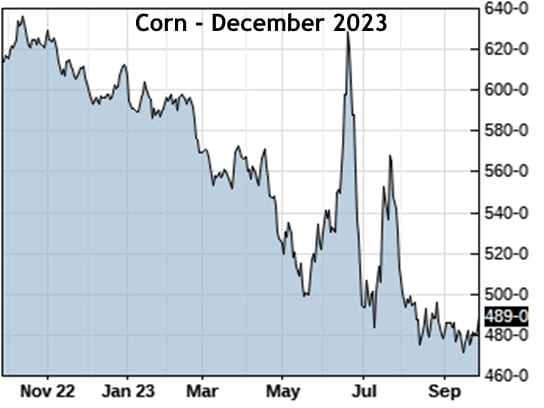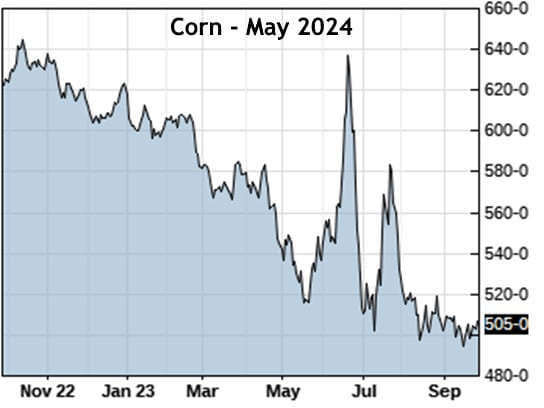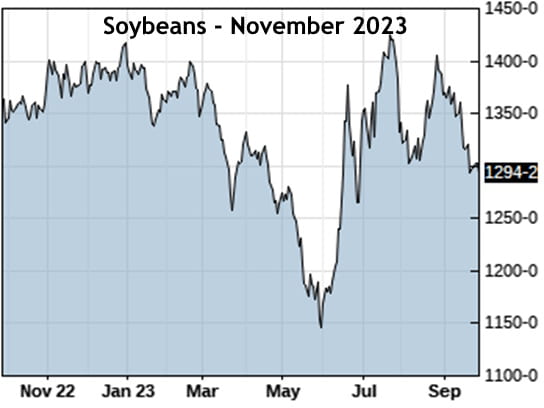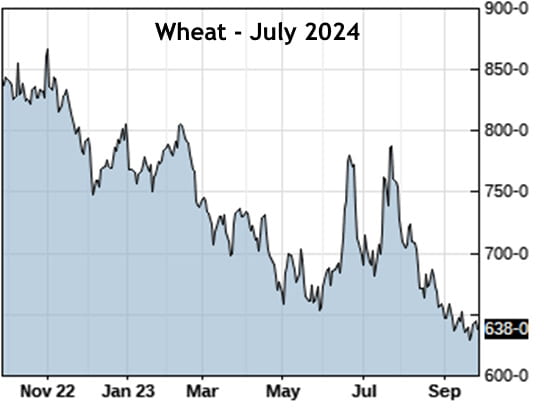Nate Bruce, Farm Business Management Specialist, nsbruce@udel.edu
New corn prices traded in the $4.70 to $5.00 per bushel range throughout the month of September. December corn rallied in the second half of the month after trading in the $4.75 range, increasing by over $0.10 per bushel. Corn harvest is well underway, and yields have been what was expected thus far, particularly in the eastern Corn Belt. Western Corn Belt yields have underperformed, but it is still early. The bottom in corn prices might be close as many commercial companies started buying back their short positions throughout the month of September. Soybean prices were in retreat throughout the month of September, trading at the lowest levels since December 2021. Soybean prices were bullish coming into the September, trading above $14.00 per bushel. The margin for error on soybeans is still very tight with only a marginal carryover, however, bullish markets need bullish news to continue, and the opposite has occurred recently. Early harvested soybean acres show higher than expected yields in the eastern Corn Belt. In the western corn belt, yields have been highly variable. Yields in the next two weeks will tell the true story. Wheat prices were volatile over the course of the month, with July 24 Wheat (ZWN24) trading in the $6.20 to $6.60 range. The wheat market has been extremely challenging to navigate as downtrends continue to occur when the market appears to reach a bottom.
The September USDA World Agriculture Supply and Demand Estimates Report (WASDE) estimated corn ending stocks increasing by .86% from the August 2023/24 outlook estimate from 2,202 million bushels to 2,221 bushels. Beginning stocks for corn decreased slightly from 1,457 million bushels to 1,452 million bushels. The September USDA WASDE report increased production and supply from the August estimate. Corn demand remained unchanged from the August estimate. The corn season-average farm price per bushel remained unchanged at $4.90 per bushel. The USDA WASDE estimated soybean ending stocks decreasing by 10.20% from the August 2023/24 estimate from 245 million bushels to 220 million bushels. The USDA WASDE report estimated decreased beginning stocks from the August 2023/24 outlook estimate increasing from 260 million bushels to 250 million bushels. Supply decreased in the September WASDE with reductions in both production and beginning stocks. The September estimate slightly reduced the bushel yield harvested per acre from 50.9 bushels to 50.1 bushels. Soybean demand decreased in the September estimate as well, with reductions in crushing demand and export demand. The soybean season-average farm price per bushel increased again from $12.70 per bushel to $12.90, due primarily to decreased estimated production. The September USDA World WASDE estimated wheat ending stocks remaining the same at 615 million bushels. Wheat demand and supply remained unchanged from the August estimate. The average farm price per bushel also remained unchanged at $7.50 per bushel. The next USDA WASDE report will be released on Thursday November 9th.
In international grain market news, Russia continues to attack vital Ukrainian grain export infrastructure since terminating the Black Sea grain corridor agreement. Several grain export facilities in the major Black Sea port of Odessa were destroyed these attacks. The United States and the European Union are assisting Ukraine in finding alternative grain export routes through Romania and Moldova to avoid drastic impacts on global food supplies. The European Union trade commissioner seeks working with China to help restart the Black Sea grain deal. China formerly received a quarter of the overall grain exported under the Black Sea corridor agreement. Brazil’s corn and soybean exports in September well surpassed levels a year ago with the country shipping 5.30 million tons of soybeans and 7.28 million tons of corn. The soybean planting window is fast approaching in Brazil but could be delayed as the forecast for the next two weeks is hot and limited showers. A delayed planting could result in a delayed harvest, impacting the planting of the Brazilian second corn crop (safrinha corn). Safrinha corn accounts for 75% of the total corn production in Brazil and yields could be underwhelming if planted late.
Corn Futures



Soybean Futures



Wheat Futures



